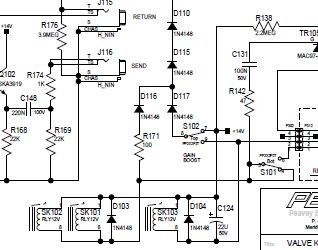I've got a Peavey Valve King combo here in the shop that has me puzzled. It came in completely dead and inspection revealed a shorted power tube and a blown filament fuse on the board. Further checking showed that two of the diodes in the filament bridge supply were bad. I changed out all four filament diodes and was rewarded with filament voltage and a pilot light. Great, I thought, this thing will go away and leave me happy. No such luck.
the channel switching didn't and doesn't work. On one side of R212 I have about 30v, but on the other side what's supposed to be 14v (enough to energize the switching relays) is only about 3v. At rest the 5w 400 ohm resistor measures about 250 ohms.
I'm suspicious of C216. I replaced D103 and D104 on the theory that what damaged the rest of the diodes might have done a job on these but it didn't fix the problem.
Any thoughts as to what could be dragging the voltage down? Any and all suggestions gratefully accepted.
I've included a clip of the filament supply

and where the 14v is supposed to go

the channel switching didn't and doesn't work. On one side of R212 I have about 30v, but on the other side what's supposed to be 14v (enough to energize the switching relays) is only about 3v. At rest the 5w 400 ohm resistor measures about 250 ohms.
I'm suspicious of C216. I replaced D103 and D104 on the theory that what damaged the rest of the diodes might have done a job on these but it didn't fix the problem.
Any thoughts as to what could be dragging the voltage down? Any and all suggestions gratefully accepted.
I've included a clip of the filament supply

and where the 14v is supposed to go

Comment